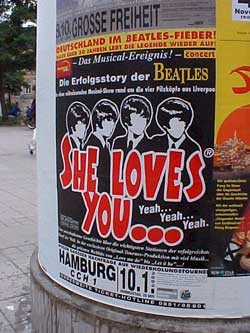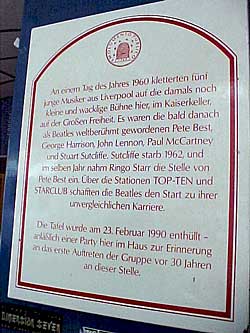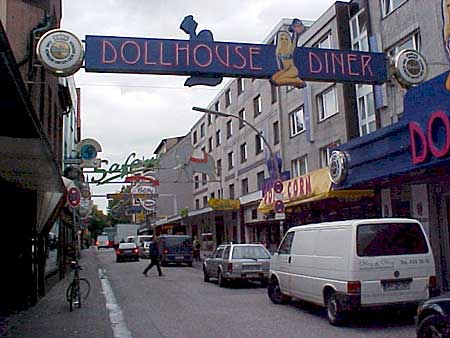|
 There are countless times in life when, years later, we encounter the stomping grounds of historical and cultural icons. We follow their footsteps to where they lived, ate and worked—and lament how the neighborhood has gone to hell in a handbasket, or some such thing. Conversely, like those who rue the day that the sullied and dependably tawdry Times Square was Disney-fied, there are places where the singularity and even lawlessness of the past is replaced by a safe, typical, tourist-catered environment. There are countless times in life when, years later, we encounter the stomping grounds of historical and cultural icons. We follow their footsteps to where they lived, ate and worked—and lament how the neighborhood has gone to hell in a handbasket, or some such thing. Conversely, like those who rue the day that the sullied and dependably tawdry Times Square was Disney-fied, there are places where the singularity and even lawlessness of the past is replaced by a safe, typical, tourist-catered environment.
The neighborhood in Hamburg where the Beatles learned their chops falls somewhere in between. It hasn’t gone to hell because it wasn’t quite an upstanding area to begin with. And it hasn’t exactly been cleaned up, either, as it still hosts a thriving sex shop district on par with Amsterdam’s red light district.
Most interestingly is how this area’s cemented place in rock history has, and has not, been celebrated. The neighborhood hasn’t capitalized on it in the way one would expect, the way that former Hemingway haunts, for example, have all taken up the mantle of unofficial shrines to Papa. All the plaques and signs commemorating the Beatles, save for one small paper notice at one location, are in German only, with no English—the language not just common amongst international tourists but of the very bandmates being commemorated—translations at all. And none of the clubs where they played remain in their original incarnation. Each has been gutted, remodeled or otherwise altered to either accommodate modernity or due to the realities of business in the past 40 years.
On the 7th of August, 1960, the Beatles arrived in Hamburg and began playing at the Indra Club. This was back when Stu Sutcliffe was playing bass and Pete Best was on drums. The club still exists today, in a manner of speaking—it’s a new place on the original location. The exterior is decorated with photos of Jimi Hendrix, Frank Zappa and others, and there are decorations of musical instruments both as posted paintings and in the cast iron bars of the gate. At the time the Beatles were appearing at the Indra, from August until November, they lived a few minutes away at a movie theater, the Bambi Kino—behind the screen, we are told—at Paul-Roosenstrasse 33. The Bambi Kino, like the Indra Club, was owned by Bruno Koschmider and did not exactly provide the young band with the lodging amenities they would later be afforded. Today it is, in fact, an apartment building, with the garage in the place of the original entrance to the cinema.
Next up was the Kaiserkeller Club, a half-minute walk from the Indra. According to information in the display window outside the old Kaiserkeller, it was on the 4th of October that Koschmider moved the band from the Indra Club to this larger venue. "It was a definite improvement over the Indra," the small sheet of paper in English reads, "there was a nautical theme to the place, with rigging and lifeboats decking the interior. It had a big stage, good lighting and a regular audience." Though the club had been set up to attract a younger crowd, with afternoon shows comprised mostly of teenagers, the club changed at 10 each night, when nobody under 18 was permitted inside. Many were too intimidated anyway, thanks to the rough, leather-clad rock fans that would show up for a night of music, drinking and fighting. Each night, Koschmider would alternate two bands, each with an "hour on, hour off" schedule. The Beatles played there until the end of November.
The Kaiserkeller is presently called by its address, Freiheit 36, though the original name is retained in a sort of sub-heading on its sign. Remodeled and expanded, the new place is still a music venue. The October schedule at the Freiheit 36 has Brian Setzer, Weezer and the Rollins Band performing. The last decade alone has seen acts such as R.E.M., Nirvana, Pearl Jam, the Black Crowes, Neil Young, John Hiatt and more. In other words, it has remained a source of interesting rock and roll from further west. The new club is slightly to the right of the original one, with the original entrance one address to the left, at the corner itself, of the streets Grosse Freiheit (German for grand freedom) and Simon von Utrechtstrasse.
At the Kaiserkeller’s entrance is a plaque in German, posted only eleven years ago, which reads:
 On a day in the year of 1960, Five young musicians from LiverpoolPete Best, George Harrison, John Lennon, Paul McCartney and Stu Sutcliffe later known as the Beatles. Sutcliffe died in 1962,and the same year Ringo Starr replaced Pete Best. And via theTop Ten Club and The Star club it was the beginning of theirUnparalleled career. On a day in the year of 1960, Five young musicians from LiverpoolPete Best, George Harrison, John Lennon, Paul McCartney and Stu Sutcliffe later known as the Beatles. Sutcliffe died in 1962,and the same year Ringo Starr replaced Pete Best. And via theTop Ten Club and The Star club it was the beginning of theirUnparalleled career.
Ringo did not come from far away; he was the drummer for Rory Storm and his Hurican (also referred to as Rory Storm and the Hurricanes), the other Liverpool band that played shows with the Beatles at the Kaiserkeller—and received top billing. However, the Beatles as second banana wasn’t something that continued for long.
Not longer after their reign at the Kaiserkeller, the Beatles were deported back to England. Apparently, once they started to play at the Top Ten Club (formerly at Reeperbahn 36, a few streets away, the site is now the discreet Weller’s Hotel), Koschmider, angry at the apparent disloyalty of the band, informed the police that George Harrison was still only 17. Moreover, he had Paul and Pete arrested for reportedly setting fire to a condom inside the Bambi Kino movie theater. They were sent home the following day.
But their time in Hamburg was not over. The Beatles returned at the end of March 1961, at the request of a different promoter, with a now 18-year-old George Harrison in tow, playing again at the Top Ten Club until the beginning of July. They lived in the attic above the club during this period. One has to wonder how the band occupied their downtime, what with their work and home in the epicenter of Hamburg’s sex district.

April of 1962 marked their third sojourn in Hamburg. By this time, Stu had left the band and was staying in Hamburg to focus on art and be with his girlfriend, Astrid Kirscher (he died of a brain hemorrhage a day before the band returned to town). This time, the Beatles played at a large venue called the Star Club, a new, even bigger club that was located across the street from the Kaiserkeller. John, Paul, George and Ringo played here from April 13th to May 31st and again in November and December. And as 1962 wound to a close, radio stations were already playing Love Me Do.
For another seven years, the Star Club, which burned down on December 31, 1969, was host to many of the great American musicians of the era such as Jimi Hendrix, the Who, Ray Charles, Gerry and the Pacemakers, Bo Diddley and more. There is a large plaque commemorating the Beatles as well as these other musicians, a plaque that is inside a bit of a courtyard area. Presently, there is a smaller café called Star Clubhof, as well as several Thai restaurants and an unambiguous sign on a doorway to a stairwell that reads "THAI GIRLS." Music is thumping from down below, but it isn’t the Beatles.
The Berlin Wall went up in between Beatle sojourns in Hamburg, probably a contributing cause for bringing them, and other musicians from England and the U.S., back to Germany. Despite Hamburg being a part of the West, and therefore free, there was no doubt a heightened urgency for the musical freedom that allowed the people here to look further in that direction and not toward the constrictions of the East. There is a sign for the original opening of the Star Club that reads:
"Suffering is over,
The time of village music is over.
Friday, the30th of April the Star Club is opening."
The first line is a reference to the lack of good music in Hamburg, but it is impossible not to read into it a political-social connection as well.
The Beatles’ presence in Hamburg will always be felt, as if they were hometown boys who made good. There is even a celebratory theatrical play being done here this coming winter. In retrospect, it is fascinating to see this world, a seediness that is most definitely the opposite of the image that the four boys innocently projected when they arrived on American shores, singing, "I Want To Hold Your Hand." Indeed, the images of the British Invasion that the Beatles ushered in were a far cry from their greaser, post-Motown rock and roll in a sex-drenched part of a German town. Until they let their hair down, as John sang in "I’ve Got A Feeling," and began sonic exploration unlike their early work, the Hamburg era was their anti-establishment outlet. Then they just tucked in their shirts for a few years as they began their ascent into pop iconography.
At the Greta and Alfons café, a relatively quiet establishment a few doors down from the Star Club, there is a large framed poster of Paul McCartney from his 1989 tour. Posted crooked in the frame as well is a bill that is marked with his signature and the words "paid in full," covering debts of a drinking tab 30 years earlier. Rather than spotlighting this, the poster just hangs quietly at the dark end of the bar, easy to miss. The bartender, an older woman, makes pleasant conversation with those in attendance. A man walks inside, sits down near the McCartney poster and orders a beer, gazing only in the other direction.
[Thanks to Kirsten Mueller for German translation.]
To read more of Grant's adventures in Europe, click <<HERE>>
|